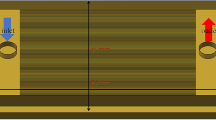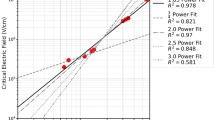Abstract
Stacked superconducting strips are widely used in electrical equipment to improve their electrical characteristics, but AC loss can seriously affect the performance of this equipment. Therefore, developing methods to reduce AC loss has long been a research hotspot in the field of superconductivity. This paper establishes a 2D densification model for stacking superconducting strips to accelerate simulation speed, and analyzes the current and magnetic field amplitude dependence characteristics of AC loss in stacked superconducting tapes based on the model. The results indicate that the amplitude of the external magnetic field has a significant impact on the total loss in the stacked strip, but a significant change in AC loss as a result of the increase in the amplitude of the transmission current is only possible when the external magnetic field intensity is less than 0.03 T. In addition, the variation in the total AC loss in the stacked superconducting tapes and the factors involved were analyzed by varying stacking conditions such as interval and number of layers.












Similar content being viewed by others
Data Availability
The data supporting the results of this study cannot be made publicly available due to the unfinished project. If the data are needed, it is necessary to explain the purpose of the data to the author. Under reasonable academic requirements, the author will provide it by email after confirmation.
References
W. Yuan, A.M. Campbell, and Z. Hongye, Comparison of AC losses, magnetic field/current distributions and critical currents of superconducting circular pancake coils and infinitely long stacks using coated conductors. Supercond. Sci. Tech. 23(8), 085011 (2010)
V.M. Zermeno, A.B. Abrahamsen, and N. Mijatovic, Calculation of alternating current losses in stacks and coils made of second generation high temperature superconducting tapes for large scale applications. J. Appl. Phys. 114(17) (2013)
C. Yu, Z. Pengfei, C. Tong, J. Shan, C. Xiaoyuan, and S. Boyang, AC loss modeling of stacked HTS tapes with economic analysis[J]. Phys. C: Supercond. prepublish (2022)
K. Kovalev, V. Poltavets, and I. Kolchanova, Superconducting technologies for renewable energy. E3S Web Conf. 124, 01043 (2019)
S.S. Kalsi, Applications of High Temperature Superconductors to Electric Power Equipment (Wiley, 2011), pp. 289–303
D. Larbalestier, A. Gurevich, and D.M. Feldmann, High-TC superconducting materials for electric power applications. Nature 414, 368–377 (2001)
M. Yazdani-Asrami, S.A. Gholamian, and S.M. Mirimani, Calculation of AC magnetizing loss of ReBCO superconducting tapes subjected to applied distorted magnetic fields. J. Supercond. Nov. Magn. 31(12), 3875–3888 (2018)
Y. Terao, W. Kong, and H. Ohsaki, Electromagnetic design of superconducting synchronous motors for electric aircraft propulsion. IEEE Trans. Appl. Supercond. 28(4), 1–1 (2018)
H.W. Cho and K.S. Haran, Force analysis of superconducting coils in actively shielded air-core superconducting machines. IEEE Trans. Appl. Supercond. 28(5), 1–8 (2018)
J. Rabbers, B. Haken, and H. Kate, Advanced ac loss measurement methods for high-temperature superconducting tapes. Rev. Sci. Instrum. 72(5), 2365–2373 (2001)
W. Li, T. Yang, and Y. Xin, Study on enhancing the interaction capacity between permanent magnets and a superconductor coil. Physica C: Supercond. 590(1), 1353946 (2021)
V.M. Zermeno, A.B. Abrahamsen, and N. Mijatovic, Calculation of alternating current losses in stacks and coils made of second generation high temperature superconducting tapes for large scale applications. J. Appl. Phys. 114(17) (2013)
X.Y. Chen, M.S. Zhang, S. Jiang, H.Y. Gou, Q. Xie, Y. Chen, and R.H. Yang, An SMES-based current-fed transformerless series voltage restorer for DC load protection. IEEE Trans. Power Electron. 36(9), 9698–9703 (2021)
X.Y. Chen, Z. Pang, H.Y. Gou, Q. Xie, R.B. Zhao, Z.H. Shi, and B.Y. Shen, Intelligent design of large-size HTS magnets for SMES and high-field applications: using a self-programmed GUI tool. Supercond. Sci. Technol. 34(9), 095008 (2021)
J.S. Murtomäki, J. Van Nugteren, G. Kirby, L. Rossi, J. Ruuskanen, and A. Stenvall, Mechanical effects of the nonuniform current distribution on HTS coils for accelerators wound with REBCO Roebel cable. IEEE Trans. Appl. Supercond. 27(4), 4100405 (2017)
J. Van Nugteren, B. van Nugteren, P. Gao, L. Bottura, M. Dhall’e, and W. Goldacker, Measurement and numerical evaluation of AC losses in a ReBCO roebel cable at 4.5 K. IEEE Trans. Appl. Supercond. 26(3), 8201407 (2016)
L. Wang, J. Zheng, F. Jiang, and R. Kang, Numerical simulation of AC loss in 2G high-temperature superconducting coils with 2D-axisymmetric finite element Mmdel by magnetic field formulation module. J. Supercond. Nov. Magn. 29(8), 2011 (2016).
K. Kevin, H. Zhang, M. Mueller, and Q. Li, Loss characteristics of HTS coated conductors in field windings of electric aircraft propulsion motors. Supercond. Sci. Tech. 33(6), 064006 (2020)
K. Kevin, Z. Hongye, M. Markus, and L. Quan, Loss characteristicsof HTS coated conductors in feld windings of electric aircraftpropulsion motors. Supercond. Sci. Tech. 33(6), 064006 (2020)
Q. Zhou, Q. Guo, and T. Su, Numerical analysis of AC losses of HTS coils with different structural parameters. J. Supercond. Nov. Magn. 34(11), 2733 (2021)
D. Gajda, A.J. Zaleski, A. Morawski, T. Cetner, M. Maleckal, and M. Rindfleisch, The optimization of Jc, Birr, n value, wires diameter, and research of the dominant pinning mechanism for applications of undoped MgB2 in superconducting multi-sectioncoils. J. Supercond. Novel. Magn. 33, 3717 (2020)
A.Y. Mohammad, S. Wenjuan, and Z. Min, AC transport loss in superconductors carrying harmonic current with different phase angles for large-scale power components. IEEE Trans. Appl. Supercond. 31(1), 3717 (2021)
L. Lai, L. Lingfeng, and G. Chen, AC loss calculation in REBCO coils or stacks by solving the equation of motion for current using an integration approach. Supercond. Sci. Technol. 34(1), 015003 (2021)
Z. Qixun, C. Shuo, G. Qian, and T. Su, Analysis of AC loss characteristics of stacked high-temperature superconducting tapes. J. Electron. Mater. 52(2), 1154 (2023)
Y. Zhang, T. Su, Q. Guo, W. Gao, J. He, T. Chen, and Q. Zhou, Investigation on variation and influencing factors of magnetization loss of HTS-coated conductor under alternating high magnetic field. J. Mater. Sci-Mater. El. 33(13), 10194 (2022)
Funding
The funding was provided by Supported by Key Research and Development Program of Shaanxi Province (Grant Number: 2023-YBGY-368).
Author information
Authors and Affiliations
Contributions
QZ and SC conceived the idea, established the model, wrote the main part of the manuscript, and analyzed the results of the simulation experiment. JW and YZ participated in the establishment of the model and the planning and implementation of the simulation experiment and helped write the manuscript. All authors read and approved the final manuscript.
Corresponding author
Ethics declarations
Conflict of interest
The authors declare that they have no conflict of interest.
Human Participants
This article does not contain any studies with human participants or animals performed by any of the authors.
Additional information
Publisher's Note
Springer Nature remains neutral with regard to jurisdictional claims in published maps and institutional affiliations.
Rights and permissions
Springer Nature or its licensor (e.g. a society or other partner) holds exclusive rights to this article under a publishing agreement with the author(s) or other rightsholder(s); author self-archiving of the accepted manuscript version of this article is solely governed by the terms of such publishing agreement and applicable law.
About this article
Cite this article
Zhou, Q., Chen, S., Wang, J. et al. Analysis of AC Loss Characteristics in Stacked Superconducting Strips in Complex Environments. J. Electron. Mater. 53, 177–187 (2024). https://doi.org/10.1007/s11664-023-10739-6
Received:
Accepted:
Published:
Issue Date:
DOI: https://doi.org/10.1007/s11664-023-10739-6




